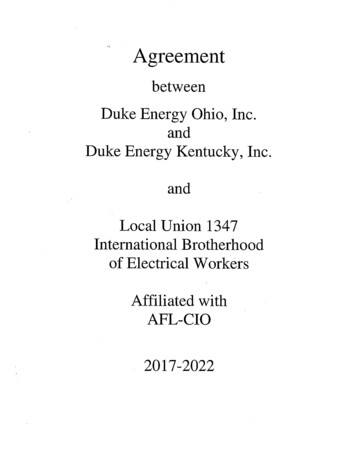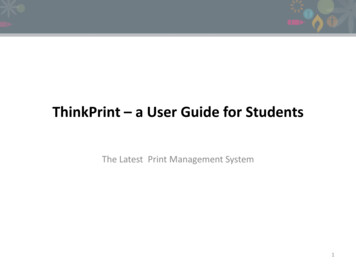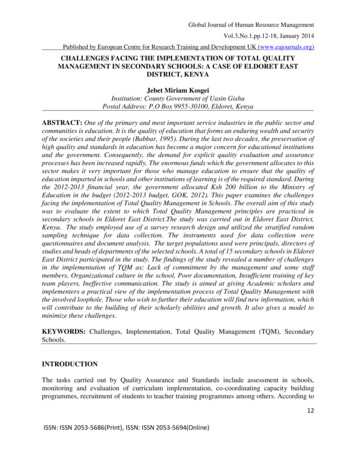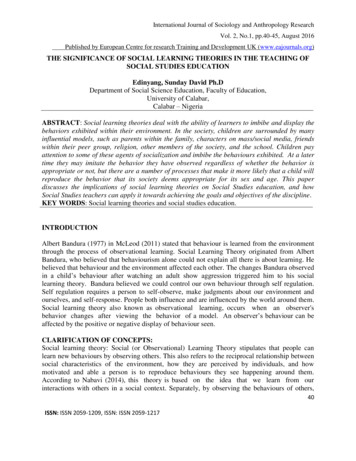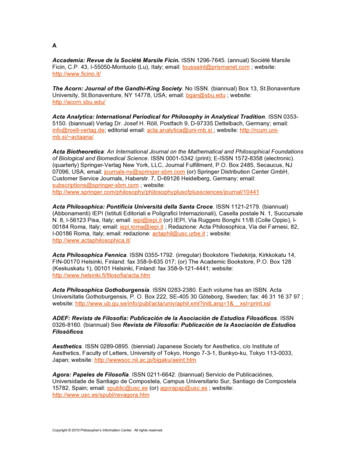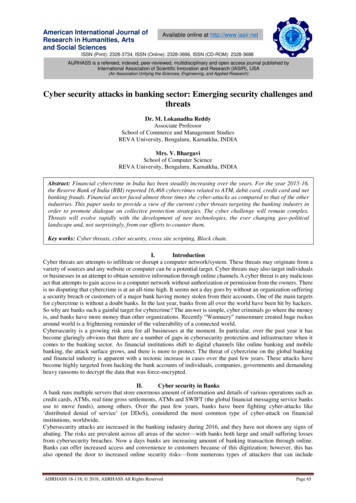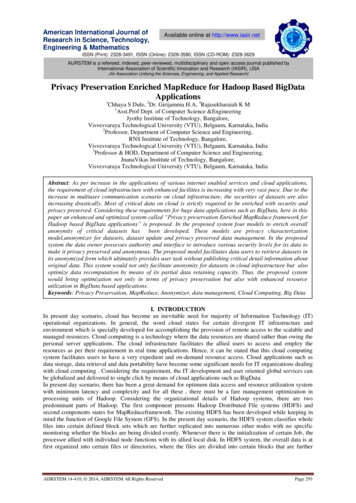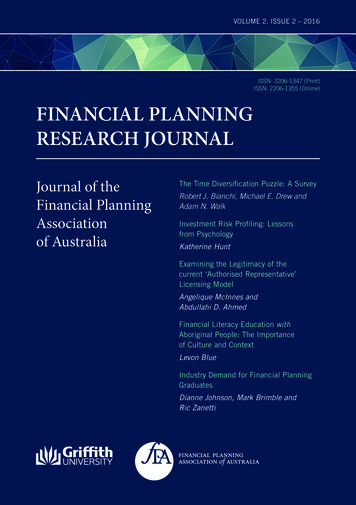
Transcription
VOLUME 2. ISSUE 2 – 2016ISSN: 2206-1347 (Print)ISSN: 2206-1355 (Online)FINANCIAL PLANNINGRESEARCH JOURNALJournal of theFinancial PlanningAssociationof AustraliaThe Time Diversification Puzzle: A SurveyRobert J. Bianchi, Michael E. Drew andAdam N. WalkInvestment Risk Profiling: Lessonsfrom PsychologyKatherine HuntExamining the Legitimacy of thecurrent ‘Authorised Representative’Licensing ModelAngelique McInnes andAbdullahi D. AhmedFinancial Literacy Education withAboriginal People: The Importanceof Culture and ContextLevon BlueIndustry Demand for Financial PlanningGraduatesDianne Johnson, Mark Brimble andRic Zanetti
Financial Planning Research JournalVOLUME 1. ISSUE 1Aims and objectivesWith an ever more complex financial system, an increasing emphasis on self-funded retirementfor Australians, the increasing size of Australia’s managed funds pool, and persistent evidence offinancial illiteracy, the importance of financial planning is clear. The financial planning professionlacked an academic platform for discourse on the issues of individual personal financial planningand wealth management, where issues of practice and policy can be debated with rigour,independence and evidence. Prior to the Financial Planning Research Journal (FPRJ), no journalsfitted into this niche to provide a forum for dissemination of research in the specific area ofpersonal finance and investments in the Australian context.The context of personal finance and investments for Australia is different from the rest of thedeveloped economies because of the presence of mandatory superannuation, a large managedfunds pool and a strong social security system. Because of these factors international journals inthe area of personal finance and/or investments may not suit an Australian audience. In addition,the rapid developments in regulatory and professional standards within the context of personalfinance suggests there should be some interest in, and need for, independent, peer reviewedresearch in this area.The FPRJ aims to publish high-quality, original, scholarly peer reviewed articles from a wide varietyof personal finance, investment and taxation disciplines. These include, but are not restricted to,economics, finance, management, accounting, marketing, taxation, behavioural finance, financialliteracy, financial education and law. The issue is that they are of interest to the practice and policyof financial planning in Australia.FPRJ is the research journal of the Financial Planning Association of Australia and ispublished by the Department of Accounting Finance and Economics, Griffith BusinessSchool, Griffith University, Australia. FPRJ is ranked on the Australian Business DeansCouncil (ABDC) quality journal publication listing and publishes two issues a year – inMarch and in September with approximately six papers in each issue.Visit our website at lfor further information.1
Financial Planning Research JournalVOLUME 1. ISSUE 1Editorial board Dr Rakesh Gupta, Griffith University, Co-EditorProfessor Mark Brimble, Griffith University, Co-Editor, Section Editor: Financial EducationSharon Taylor, Western Sydney University, Section Editor: Financial PlanningAssociate Professor Robert Bianchi, Griffith University, Section Editor: InvestmentAssociate Professor Brett Freudenberg, Griffith University, Section Editor: TaxationProfessor Michael Drew, Griffith University, Drew, Walk & CoAssociate Professor Martin Hovey, University of New EnglandMichael Perkins, Perkins FaheyDr Adrian Raftery, CFP , Deakin UniversityHoward Cook, FPA AustraliaPublisher detailsFPRJ is published by Griffith University (Brisbane, Queensland, Australia) on behalf of theFinancial Planning Association of Australia. 2016 Financial Planning Association of Australia. All rights reserved.Other journal informationOpinions and comment on papers published in FPRJ presented as Letters to the Editor arewelcome. Correspondence in connection with the FPRJ should be addressed to The Editor viaemail (editor.fprj@griffith.edu.au).FPRJ is the journal of the Financial Planning Association of Australia, Sydney NSW 2000. FPRJis published two times each year providing an outlet for research into financial planning andits related areas. No part of the material published in the FPRJ may be reproduced without thepermission of the author and FPA Australia.This publication is issued on the understanding that: (1) FPA Australia, the editors and GriffithUniversity are not responsible for the results of any action taken on the basis of informationin this publication, nor for any errors or omissions; (2) FPA Australia, the editors and GriffithUniversity expressly disclaim all and any liability to any person in respect of anything and of theconsequences of anything done or omitted to be done by any such person in reliance, whetherwhole or partial, upon the whole or any part of the contents of this publication; (3) If legal adviceor other expert assistance is required, the services of a competent professional person shouldbe sought; and (4) the views expressed in this publication are those of the contributors and notnecessarily those of FPA Australia, the editors or Griffith University. Acknowledgement of theauthor or authors, FPA Australia and FPRJ is required.If you wish to advertise an upcoming research event (forum, symposium, conference) ofrelevance to the aims of FPRJ please email the editors with the details for our consideration(editor.fprj@griffith.edu.au).2
Financial Planning Research JournalVOLUME 1. ISSUE 1Guidelines for contributors to the FPRJThe FPRJ Editorial Board welcomes original, applied and topical articles on matters of interestto the financial advice community across Australia, New Zealand and Asia that will inform thepractice and/or policy of the profession. Articles will be submitted to a double-blind review processand may be returned to authors with suggestions/comments for consideration and revision.The Editors will consult with authors as closely as possible about changes.Authors should submit complete papers that do not exceed 5,000 words not including the titlepage, abstract, tables, figures, charts, footnotes and reference list. The word count must be statedon the title page. Papers should be original works that are not under review at another journal.Submit your manuscript to fprj.editor@griffith.edu.au.Other submission requirements include: The title page should include a concise and informative title; the names and affiliations ofall authors; the name, mailing address, telephone number, fax number, and email addressof the author (or corresponding author, if more than one author); word count; and anyacknowledgments to those who assisted the authors, in a footnote asterisked to the title. The second page should repeat the title so that papers may be refereed anonymously. Thispage should also include an abstract and up to five keywords. The text of the article shouldbegin on the third page. The abstract (not more than 100 words) should highlight the paper’s relevance to the area offinancial planning. Manuscripts should be submitted in Microsoft Word format, use 1.5 spacing, A4 paper size,12 point Times New Roman font, 2.5 cm margins on all sides, and do not justify the rightmargin. Number all pages consecutively beginning with the title page and add line numbersto every page. Non-English words, such as et al., ex-post, ad hoc, per capita, Zeitgeist, or au fait, should beitalicised. Short quotations should be in double inverted commas. Longer quotations should be indentedand given without quotation marks. Full-stops and question marks should be followed by a single space. Charts, figures and text must be in black and white. There must be no use of colour. Tables and figures should be located at the end of the article. Make it clear where tables areto be inserted in the text, e.g. (Table 1 here).3
Financial Planning Research JournalVOLUME 1. ISSUE 1 The Harvard system of referencing is to be used. Examples:Books: Pyle, David J. (1997) China’s economy – from revolution to reform, Macmillan,Hampshire & London.Book chapters: Basu, P. K. and Basu, S. (2003) ‘Income generation program andempowerment of women – a case study in India’, in Raghbendra Jha (ed.)Indian Economic Reform, Palgrave-Macmillan, NY, 2003.Journal articles: Knight, J. and Shi, L. (1996) ‘Educational attainment and the rural-urbandivide in China’, Oxford Bulletin of Economics and Statistics, 58:1, pp. 83-118.Internet source: Henry, K. (2004) Australia China Economic Directions – Long TermTrends in the Australian Economy (unpublished speech at the Australia China Free TradeAgreement Conference, Sydney, 12 August), alia China FTA.pdf (accessed on 04/01/2005).Authors are advised that if submitted papers are accepted for publication in FPRJ, then theauthors will be required to complete a copyright assignment form and provide a 600-word synopsisof the paper for publication in Financial Planner Magazine.Visit our website at l for FPRJ AuthorGuidelines and copy deadlines.4
Registrations NOW OPENThe 5th Personal Finance andRegistrationInformationInvestmentSymposium2016 (PFIS)The 5th Personal Finance and InvestmentSymposium 2016 (PFIS)andandThe 2016 FinancialPlanning2016 Financial Planning Academic Forum (FPAF)Academic Forum (FPAF)Monday 21 November 2016 & Tuesday 22 November 20169 am - 5 pm, 21 and 22 November 2016RegistrationSouthto FPAFCampus& PFISParramattaWestern Sydney UniversityRegistration Closes: November 16 , 2016Cost: 170 (including GST)Registration cost includes: attendance to event both PFISRegistrationGST). Includesentry to both events,andcost:FPAF 170events,(includingmaterials, cateringand symposiumdinner.If youandwishsymposiumto only attenddinner.FPAF pleaseonlyall materials,cateringIf youwish to only attendfor that meeting( meetingNofeefeeforforattendance).Attendance)FPAF pleaseregisteronly registerfor that(no(nofee for FPAF attendance).For further information email sharon.taylor@westernsydney.edu.au.For Further information contact Sharon TaylorRegister and pay online at:email: ydney.edu.au/onestopweb/sob 001Please use link below for registration andpayment. Cut and paste link below into eStopWeb/SOB 001
Inaugural AlternativeInvestments Conference 20163–4 NOVEMBER GOLD COAST AUSTRALIAAlternatives arebecoming increasinglyimportant within thecurrent investmentenvironment of lowexpected returns.This international conference, hostedby the Griffith Centre for PersonalFinance and Superannuation, aimsto bring the best researchers andindustry professions together toshare the latest research and newideas in this important segment ofthe finance industry.Keynote speakers Dr Frederic Blanc-Brude - EDHEC Asia Pacific, Singapore Dr Anthony De Francesco - MSCI Inc. Professor Michael Drew - Griffith University, Australia Professor Joelle Miffre - EDHEC Business School, FranceProgram and RegistrationFor more information about the conference including the program,registration fees and dates, visit griffith.edu.au/aiconf.
FPA ProfessionalsCONGRESSPERTH 23-25 NOV 2016
Financial Planning Research JournalVOLUME 1. ISSUE 1From the editorsWe are pleased to present Volume 2, Issue 2 of the Financial Planning Research Journal, thejournal of the Financial Planning Association of Australia.“In this world nothing can be said to be certain, except death and taxes.” Benjamin FranklinIn the case of financial planning/financial services perhaps the above quote should be extendedto “death, taxes and uncertainty”. The last few months have certainly seen a lot of uncertaintywith market volatility, consumer/investor/business confidence hit, regulatory uncertainty oversuperannuation and professional standards, concerns over consumer outcomes from financialservices with calls for more government intervention, and further discussion of low cost options formore Australians to access financial advice, including through digtial advice platforms among othermodels of advice. Indeed, there has also been much interest regarding international developmentsand the optential impact on financial markets of ongoing conflict, humanitarian issues, the USpresidential election and movement within the European Union.For stakeholders of financial planning, there are, as always, many complex issues to exploreand to contribute towards. This FPRJ has a role to play in exploring theoretical and policy issuesrelating to the financial planning industry. This issue of FPRJ tackles a number of these issueswith investment diversification, risk profiling, licensee structures, financial literacy and demand forfinancial planning graduates examined.We once again thank the Financial Planning Association of Australia and Griffith University forproviding a platform for the dissemination and debate of research in this area. The first two editionsof the journal were well received and we hope to build on this with this and future editions of theFPRJ, and in doing so foster lively, evidence based debate in the discipline.This issue contains five articles on a range of topics. The first article in this issue by RobertBianchi, Michael Drew and Adam Walk regarding one of the most enduring puzzles of modernfinance, time diversification. The paper provides a comprehensive review of the major streams ofthought and analysis in the time diversification literature and argues that a more realistic analysisusing defensible assumptions is likely to lead to better prescriptions for improved retirementinvesting.The second paper in this edition is by Katherine Hunt and discusses the application of psychologyliterature in developing an empirical risk profiling system. The paper provides a theoreticalfoundation for considering the risk profiling system by applying the literature from self-control,optimism, financial literacy, and risk tolerance, to a risk profiling system. Dr Hunt invites readers tocontribute to further stages of this research which will focus on the development and testing of arisk profiling system based on the theory within this paper.The legitimacy of the current ‘Authorised Representative’ model is the subject of the third paperby Angelique McInnes and Abdullahi Ahmeda which applies Suchman’s legitimacy theoreticalframework to the current authorised representative licensing model to not only advance financial9
Financial Planning Research JournalVOLUME 1. ISSUE 1planning theory, but raise further questions for future empirical research, which should providepolicymakers data required to make evidence-based decisions around licensing advisers.The fourth paper by Levon Blue is regarding the role of culture and context in financial literacyeducation with a Community instead of for a Community. The findings may offer insights forfinancial educators and/or planners participating in financial literacy education and engaging withAboriginal clients.The final paper in this edition is by Dianne Johnson, Mark Brimble and Ric Zanetti and exploresindustry demand for financial planning graduates. The paper details results of a survey of 191financial planning practices on their expectations and plans for new entrants in the five years (to2019).Finally, we would like to thank the FPRJ production team for their efforts in getting the issuecompleted. Without the efforts of Dianne Johnson, Joy Lin, Sian Jones and Alicia Stokes, thisedition of the FPRJ simply would not have been produced.We hope you enjoy the third issue of the Financial Planning Research Journal.Dr Rakesh Gupta and Professor Mark Brimble10
Financial Planning Research JournalVOLUME 1. ISSUE 1Contributors to this editionRobert J. BianchiGriffith UniversityMichael E. DrewGriffith UniversityAdam N. WalkGriffith UniversityAngelique McInnesRMIT UniversityAbdullahi D. AhmedRMIT UniversityKatherine HuntGriffith UniversityLevon BlueGriffith UniversityDianne JohnsonGriffith UniversityMark BrimbleGriffith UniversityRic ZanettiZanetti Recruitment and ConsultingFPRJ Partners11
Financial Planning Research JournalVOLUME 1. ISSUE 1THE TIME DIVERSIFICATION PUZZLE: A SURVEYRobert J. Bianchi*, Michael E. Drew and Adam N. Walkaa: Corresponding authorEmail: a.walk@griffith.edu.auARTICLE INFORMATIONABSTRACTArticle History:Since Samuelson’s (1969) theoretical proof that riskand time are unrelated, a half century of debate andcontroversy has ensued, leaving time diversification asone of the most enduring puzzles of modern finance. Themost conspicuous aspect of the debate is the questionableassumptions that underlie much of the analysis. Thuswe are left with an unsatisfying debate conducted in aparadigm where terminal wealth is usually a functiononly of returns, and where time-weighted measures areassumed to adequately evaluate performance. This paperreviews the major streams in the time diversificationliterature and argues that more realistic analysis usingdefensible assumptions is likely to lead to betterprescriptions for improved retirement investing.Submitted: 11 July 2016Revision: 7 September 2016Acceptance: 8 September 2016Key words:Time diversification, Risk,Investment horizonJEL classification: G23, G11 2016 Financial Planning Research Journal*We thank the editors of the Financial Planning Research Journal, Professor Mark Brimble andDr Rakesh Gupta and the two anonymous reviewers for their comments. All errors remain ours.12
Financial Planning Research JournalVOLUME 1. ISSUE 11.0 IntroductionThe time diversification puzzle is concerned with the relationship between investment risk andinvestment horizon. Beyond this there appears little else upon which the protagonists agree. In theliterature we see a multitude of theoretical priors, schools of thought, quantitative methods, andconceptions of risk and yet we have no resolution to the debate. Why is it that a subject that hasattracted some of the most fertile minds in economics remains so elusive? In this paper, we arguethat at least part of the problem is that the debate is conducted on the wrong terms. In particular,we argue that there is too narrow a focus on returns as the sole determinant of terminal wealth.Realistic accumulation models are also a function of contributions and salary growth so withoutcorrecting the basis upon which the debate is conducted, we argue that it will remain abstract andof limited practical value.When thinking about investment risk, we anchor our work in Markowitz (1952), who consideredthe problem of portfolio choice under uncertainty1. As with much ground-breaking research,Markowitz’s (1952) modern portfolio theory was a caricature of a more complex problem. Inparticular, Markowitz (1952) considered portfolio choice in a single period setting, allowing him toremove time-variation from the problem of portfolio selection.Naturally, the financial economics literature evolved and scholars began to consider the portfolioselection problem in a multi-period setting like that encountered with practical investmentproblems. Chief among these scholars was another Nobel Prize winner – Paul A. Samuelson – whoconsidered the problem in a multi-period setting using expected utility theory. Samuelson’s (1969)work is of particular interest for two reasons. Firstly, he was amongst the first to bring the geniusof Markowitz’s (1952) work into a multi-period setting which by itself is remarkable2. Secondly,and particularly germane to this paper, Samuelson (1969) initiates the time diversification debateby considering whether the concept of diversification works with time, in the same way as itdoes amongst assets or securities (cf. Markowitz, 1952). In order to study the existence of timediversification, Samuelson (1969) selects the classical expected utility theory as his framework ofchoice. Expected utility theory is thus the point of departure for the time diversification debate, andall other competing streams or schools of thought tend to emerge at least in part as a reaction toSamuelson’s (1969) work.A literature review on time diversification without a discussion about expected utility theory, orany of the other major competing schools of thought, would (and should) be regarded as lacking.In order to synthesise the time diversification debate, we must conduct a critical survey of theliterature. Fortunately, without too much effort, a process of taxonomy results in a number ofdistinct streams or schools of thought. Each of these competing schools tends to coalesce aroundan alternative theory to, or a common critique of, expected utility theory. The battle of ideasbetween these schools of thought has led to time diversification becoming one of finance’s mostenduring puzzles.Markowitz’s contribution earned him a share in the 1990 Sveriges Riksbank Prize in Economic Sciences in Memoryof Alfred Nobel.2 Others include Tobin (1965) and Merton (1969).113
Financial Planning Research JournalVOLUME 1. ISSUE 1Following the literature more or less chronologically, we commence the formal review of theliterature with the expected utility theory stream beginning with Samuelson (1969). In thisseminal work, Samuelson (1969) isolates the relationship between risk and time by observingthe optimal allocation to risk assets with horizon, based on three assumptions. While a numberof proponents confirm the mathematical certainty of his findings, even more scholars – includingsome who are otherwise advocates of expected utility theory – call into question Samuelson’s(1969) assumptions. In fact, it is Samuelson’s (1969) three assumptions –which will be scrutinisedthroughout this paper – that provide later scholars the oxygen to keep the time diversificationdebate burning.From the initial stream of work led by Samuelson (1969), the rise of the Black-Scholes-MertonOption Pricing Theory – another Nobel Prize winning idea – offered a convenient basis upon whichBodie (1991, 1995) could observe risk3. Bodie (1995) concluded that, because the price of a putoption increased with investment horizon, so did risk. The option pricing theory approach of Bodie(1991, 1995) apparently emerged because of this unrelated breakthrough in economics, not as aresult of a specific critique of Samuelson’s (1969) work. Only later, did others highlight that Bodie’s(1995) approach appeared to offer an objective measure of risk, in contrast to Samuelson’s (1969)normative treatment4. After Bodie’s (1991, 1995) early contribution, the option pricing theoryschool of thought tended to degenerate into semantic debates about whether Bodie (1995) wascorrectly identifying the price of insurance, and relating it properly to the investment horizon. Aftera burst of scholarship in the late 1990s, this stream in the time diversification literature has tosome degree faded away. Perhaps the most substantial critique of Bodie’s (1995) work was that itwas conducted in a risk-only framework. In a sense, this is understandable given the relationshipof interest in the time diversification debate is the one between risk and investment horizon. On theother hand, opponents questioned whether it is appropriate to separate risk from return, therebyoverlooking one of investment’s key trade-offs.It is a generalisation that behavioural economists inevitably end up becoming amongst the mostvocal opponents of any framework that tends to see economics as (hard) science, as opposedto social science. These two visions of economics mix like oil and water. Behavioural economistsintroduce the richness of humanity to economic problems, often in qualitative terms, whereas“scientists”, of whom Samuelson (1969) was most definitely one, prefer to take approachescharacterised by theoretical formality and the rigour of mathematical reasoning, even if it meansmaking simplistic assumptions about human behaviour. In these few sentences, we have brieflyoutlined both the behaviouralists’ principal critique of Samuelson (1969) – the inappropriatenessof his underlying assumptions – and our critique of the behavioural stream of literature – thelack of framework, and negative approach to the problem. From the authors’ observation of theliterature, the behaviouralists tend to avoid the formal frameworks of economics in analysing theRobert C. Merton and Myron S. Scholes shared the 1997 Sveriges Riksbank Prize in Economic Sciences inMemory of Alfred Nobel. Fischer Black died of cancer in 1995. Because the Prize in Economic Sciences isnot awarded posthumously, Black is not formally recognised as a laureate although his contribution is beyondquestion.4 Recall, that to study risk by estimating the optimal allocation to risk assets, Samuelson (1969) first had toassume the investor’s form of risk aversion.314
Financial Planning Research JournalVOLUME 1. ISSUE 1question at hand. By way of analogy, behaviouralists could be described as the insurgents of thetime diversification debate. They appear on the scene, they challenge the entrenched position withthe insights of psychology, only to retreat without leaving a tangible alternative framework. From theliterature review conducted in this paper, we will see that the influence of the behaviouralists is thuslimited to providing critiques of the other streams of the literature. Notwithstanding its limitations, thebehavioural stream in the literature does provide some compelling insights, particularly relating tothe selection of risk measures for examination.The final stream in the literature – what Booth (2004) describes as the “applied” stream – is definedmore by what it’s not, than what it is. While the applied stream is a somewhat nebulous confectionof studies, there is the faint semblance of a unifying theme. Scholars who pursue this path tend toapproach the problem of time diversification empirically, and without resting on a theoretical edificeas the more established streams tend to. Simulation techniques are also a common methodologicalchoice as Booth (2004) suggests. Parallel to the time diversification debate, has emerged a richliterature on risk measures. Leaning on this literature, applied scholars tend to define risk in acertain way – for example, value-at-risk – and then proceed to estimate their selected risk measureover a number of horizons of different lengths. Scholars then draw conclusions about the presenceor otherwise of time diversification by applying reasoning to these estimates. Naturally, it is possibleto define risk in many ways and so the applied stream has tended to grow as new conceptions ofrisk emerge. As will become evident from this paper, some scholars have even developed measurespurely for the purposes of analysing the time diversification question.So, almost fifty years after the debate began, we continue to see studies emerge which seek toresolve the debate. As noted, several recent studies have even introduced particular measureswhose sole purpose is to shed light on this debate. And yet the puzzle remains unresolved. It wouldthus be fair to say that there are a number of entrenched camps who are unable to agree on acommon basis from which to the advance the argument. This paper does not seek to induce thedebate’s antagonists to recant. Rather, by leveraging off aspects of each stream in the literature,and attempting to synthesise the debate, we set out to offer an alternative view of the relationshipbetween risk and investment horizon. Thus, as has happened to the option pricing theory streamto some extent, sides in the debate are lost to time. This Kuhnian (1970) process reminds us of afamous quotation which, ironically enough, is attributed to Samuelson: “Funeral by funeral, theoryadvances (Wilson, 1998, p.52).”This paper is about the relationship between investment risk and investment horizon, not about theobjective merits of expected utility theory, or any of the other schools of thought we discuss. Weaccept there are other economic problems where any one of these frameworks might represent thesuperior framework within which to approach the given problem. Our interest here is whether thegiven framework – for example, expected utility theory – is the best approach to gleaning positiveinsights into the puzzle of time diversification. We posit that our critique should therefore be viewednarrowly through the lens of the purpose of this paper.We agree with Kritzman (2000) that, as far as the debate thus far goes, everyone is right on theirown terms. The entrenched camps do not seem to be budging from their position. But given the15
Financial Planning Research JournalVOLUME 1. ISSUE 1magnitude of financial assets associated with long-horizon investing, and the continued shift todefined contribution style plans, we argue that scholars do not have the luxury of conductingsemantic debates about abstract ideas. We argue that the first step is to locate the debate inreality but incorporating realistic accumulation models in analysis, and then to apply the flexibleempirical approaches preferred by the applied stream in the literature. By doing this we believethat practitioners can apply insights from scholarly research to improve outcomes for their planmembers.Before we begin our detailed examination of the literature, we will first summarise the evolution ofideas that led to the time diversification debate as necessary context. The literature review thuscommences with a discussion of the work of Markowitz (1952).2.0 The time diversification puzzle2.1 Markowitzian originsThe principle concern of the time diversification debate is the relationship between investment riskand the investor’s horizon. But before we explore the subject in detail, we must first anchor thework in the field of finance. Fortunately, when it comes to investment – or, in formal terms, portfoliochoice – we can rely on one of t
Associate Professor Martin Hovey, University of New England Michael Perkins, Perkins Fahey Dr Adrian Raftery, CFP , Deakin University Howard Cook, FPA Australia Publisher details FPRJ is published by Griffith University (Brisbane, Queensland, Australia) on behalf of the Financial Planning Association of Australia.

